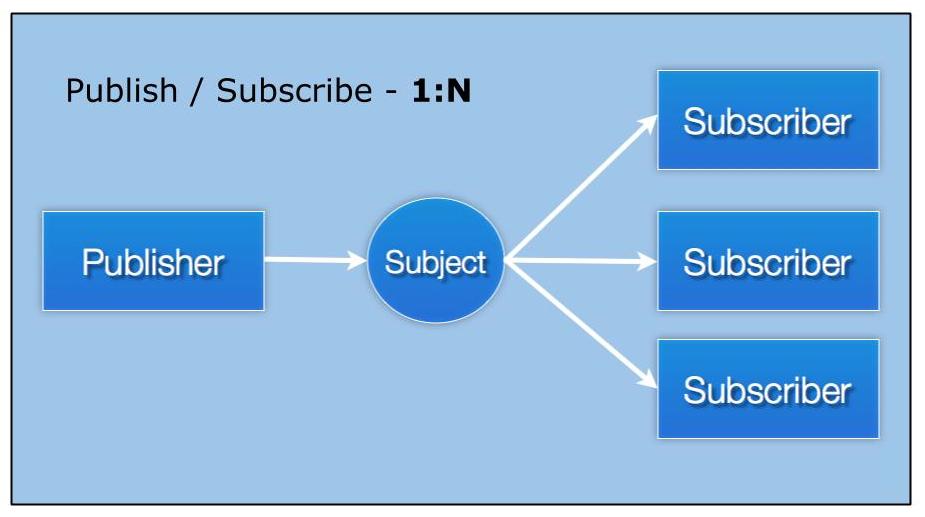Package Exports
- loopback-component-pubsub
This package does not declare an exports field, so the exports above have been automatically detected and optimized by JSPM instead. If any package subpath is missing, it is recommended to post an issue to the original package (loopback-component-pubsub) to support the "exports" field. If that is not possible, create a JSPM override to customize the exports field for this package.
Readme
LoopBack Component PubSub
A LoopBack Framework Component that provides publish events over WebSockets.
This module will provide publish/subscribe functionality for LoopBack Framework Models that implements the PubSub Mixin.
Publish Subscribe
The publish/subscribe pattern allow clients to subscribe to specific events, listening for data streams a server publish everytime there are new changes.

Installation
$ npm install --save loopback-component-pubsubSetup Module
Update the server/component-config.json as follows:
{
"loopback-component-explorer": {
"mountPath": "/explorer"
},
"loopback-component-pubsub": {
"auth": true
}
}
Update the server/model-config.json as follows:
{
"mixins": [
"loopback/common/mixins",
"loopback/server/mixins",
"../common/mixins",
"./mixins",
"../node_modules/loopback-component-pubsub/mixins"
]
}Configure Models
Thanks to the provided mixin, you are able to define in which Models you want to make available the PubSub functionality by explicitly defining it in the model json file.
{
"mixins": {
"PubSub": true
}
}Update Server File
Update the start method within the server/server.js file as follows:
app.start = function() {
return server = app.listen(function() {
app.emit('started', server);
var baseUrl = app.get('url').replace(/\/$/, '');
console.log('Web server listening at: %s', baseUrl);
if (app.get('loopback-component-explorer')) {
var explorerPath = app.get('loopback-component-explorer').mountPath;
console.log('Browse your REST API at %s%s', baseUrl, explorerPath);
}
});
};How to subscribe to events
Un-Authenticated Vanilla JavaScript Example
You can subscribe to any valid remote method within your model as follows:
<html>
<head>
<title>Event Source Test</title>
<script src="/socket.io/socket.io.js"></script>
<script>
var client = io('http://localhost:3000');
// subscribe for newly created rooms
client.on('[POST]/api/rooms', function (room) {
console.info('Room ', room);
});
// subscribe for new messages in the room with Id 1
client.on('[POST]/api/rooms/1/messages', function (message) {
console.info('Message ', message);
});
</script>
</head>
<body></body>
</html>Authenticated Vanilla JavaScript Example
You can subscribe to any valid remote method within your model as follows:
<html>
<head>
<title>Event Source Test</title>
<script src="/socket.io/socket.io.js"></script>
<script>
var client;
// Ajax Request logic to login and to get a token [/POST]/api/users/login
// Use whatever method works best for you when doing AJAX Requests
userLogin(function onLogged(token) {
client = io('http://localhost:3000');
client.on('connect', function onConnect() {
client.emit('authentication', token);
client.on('unauthorized', function onUnauthorized(res) {
console.error('Unauthenticated', res);
});
});
// subscribe for newly created rooms
client.on('[POST]/api/rooms', function (room) {
console.info('Room ', room);
});
// subscribe for new messages in the room with Id 1
client.on('[POST]/api/rooms/1/messages', function (message) {
console.info('Message ', message);
});
});
</script>
</head>
<body></body>
</html>NativeScript2 SDK Example Un-Authenticated
When using the loopback-sdk-builder
import { Component } from "@angular/core";
import { API_PROVIDERS, LoopBackConfig, RoomApi } from './sdk';
@Component({
selector: "my-app",
templateUrl: 'path/to/view.html',
providers: [ API_PROVIDERS ]
})
export class AppComponent {
constructor(private room: RoomApi) {
// or local network IP or public IP/DNS
LoopBackConfig.setBaseURL('http://192.168.1.11:3000');
LoopBackConfig.setApiVersion('api');
room.onCreate().subscribe((res: { id: number | string }) => {
alert(res.id);
});
room.onCreateMessages(1).subscribe((res: { text: string }) => {
alert(res.text);
});
}
}
NativeScript2 SDK Example Authenticated
When using the loopback-sdk-builder
import { Component } from "@angular/core";
import { API_PROVIDERS, LoopBackConfig, UserApi, RoomApi } from './sdk';
@Component({
selector: "my-app",
templateUrl: 'path/to/view.html',
providers: [ API_PROVIDERS ]
})
export class AppComponent {
constructor(private room: RoomApi, private user: UserApi) {
// or local network IP or public IP/DNS
LoopBackConfig.setBaseURL('http://192.168.1.11:3000');
LoopBackConfig.setApiVersion('api');
user.login({ email: 'test@test.com', password: 'test' }).subscribe(res => {
console.info('User has been authenticated over HTTP', res);
room.onCreate().subscribe((res: { id: number | string }) => {
alert(res.id);
});
room.onCreateMessages(1).subscribe((res: { text: string }) => {
alert(res.text);
});
});
}
Tutorials
The Ultimate Guide for Building Real Time Applications
TODO
- Implement Clustering Functionality

